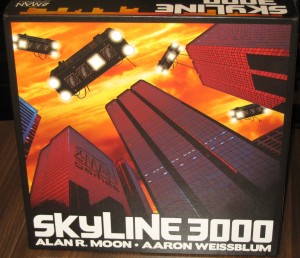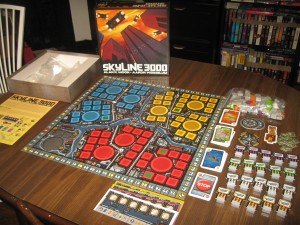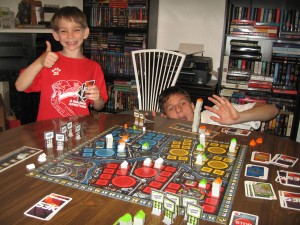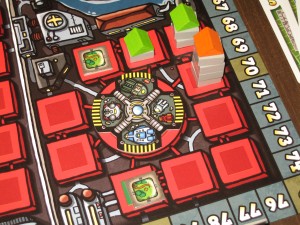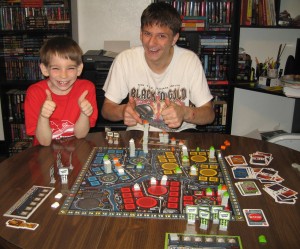I was on the fence when I discovered this game for the first time on Board Game Geek. I enjoy a good city builder game but the reviews were fairly mixed. I also had to consider that the name, “Alan R. Moon” was on the box…the same person who designed Airlines Europe and Ticket to Ride, both of which I own and love playing. I then discovered the game on sale on Tanga* for $12.99 and I figured I’d take the plunge and see what it was all about. It’s…interesting to say the least.
“Skyline 3000″ tasks players with creating and placing buildings in order to score the most victory points. In order to keep this review moving, I’ll only touch on the rules briefly. If you are interested in reading about the game’s rules in more detail, you can do so by checking out the manual here: Skyline 3000.
Components
Game Board – The board is divided into three districts, symbolized by their respective colors (red, blue, and yellow). Each district has three blocks, which are separate of one another. A block will consist of small squares (called platforms) that buildings, billboards, and greenspace tiles can placed on, and a larger circle that megmalls and spaceports can be placed on. The victory point track is located around the outside of the board, similar to Ticket to Ride. Players will be using small cylinder pieces as their point trackers.
Plants – Each player will receive a plant, which is a rectangular board that houses six construction squares. Players will be constructing their buildings here before placing them onto the game board.
Cards – There are four different kinds of cards: Roof Cards, Floor Cards, Contract Cards, and STOP Cards. Players will be using these cards for different things throughout the different phases of the game.
Tiles – There are three different kinds of tiles: Megamall Tiles, Spaceport Tiles, and Greenspace Tiles. These will be placed on the board throughout the game and serve as bonuses for scoring and when drawing new cards.
Building Pieces – There are grey, rectangular floor pieces as well as curved and pointed roof pieces that serve as the building blocks for your buildings. Billboards can be placed on the board to reserve spots for your buildings, for a small cost of victory points.
Key – The key is given to the player who will be going first that round. The key moves around the board clockwise at the start of every round.
Setup
1. Each player receives the roof tiles and billboards of their color, and their score marker is placed on the “5″ on the scoring track.
2. Shuffle the roof, floor, and contract cards separately. Deal two roof cards, two-floor cards, and four contract cards to each player. Finally, place each deck face up next to the board. Each player receives one STOP card.
3. Each player seeds their plants with a total of four premade buildings, one on each square. These will be a combination of one and two-story buildings with pointed or curved roofs.
4. There are four squares on the board that are filled with green…place one greenspace tile per square. There is a small section of the board devoted to auctions…place four greenspace tiles on “1″, four greenspace tiles on “2″, and the four megamall and spaceport tiles on the “3″ with the spaceport tiles on top.
5. The starting player, who is chosen at random, gets the key.
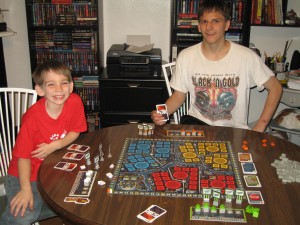
Skyline 3000: Setup. For those of you who love to nitpick…Yes, I’m aware that the score markers weren’t on “5″, we rectified that after the picture was taken.
Gameplay
The game consists of four rounds, each of which has four phases which can be described as follows:
Construction Phase:
Players will be taking turns playing one card at a time until they wish to “pass”. In this phase, players ignore the numbers on the cards and focus on the type of card.
-Floor cards allow players to take two floors from the pool and place them on any new space or unfinished building in their plant.
-Roof cards allow players to take a roof of their choice and place it on any unfinished building in their plant.
-Contract cards allow players to take a finished building in their plant and place it on the board, on the color district shown on the card. There are some limitations to what you can place where, but you can read more about that in the manual.
Players have the option of playing a billboard on a small platform to reserve a space, but they must pay a victory point to do it.
Improvement Phase:
I personally call this the “auction phase.” Using the cards that are left in their hands from the construction phase, players will be trying to outbid their opponents for the greenspace and spaceport / megamall tiles. During this stage, only the numbers on the cards matter. Players will be using the STOP card in conjunction with the sum of the cards they have chosen to bid with for a particular tile.
First, the greenspace tile on the “1″ is auctioned off and the winner gets to place it on any unoccupied platform / space on the board. The same happens for the greenspace tile on “2″. Finally, the spaceport or megamall is auctioned off in the same manner, the tile type depending on what round it is.
The winners of auctions lose their cards, but the losers get to place them back in their hand for future bidding.
Scoring Phase:
Each of the nine blocks are scored separately. The player with the most floors in that block wins “first place” and the player with the second most floors wins “second place.”
Both the first and second place winner receive: one point for each greenspace tile in that block + one point for each billboard (of any color) in that block. The first place player receives two extra bonus points.
If the megamall is located in that block, the final point values for the first and second place winner are doubled.
Players will adjust their score marker accordingly as blocks are scored.
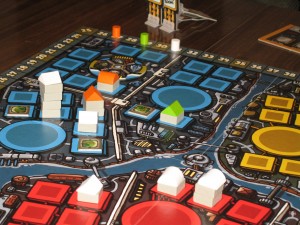
Each block is scored separately, allowing players to monopolize some areas while completely ignoring others.
Draw Phase:
Starting with the key player, players draw six cards, in any order from any of the three piles they want. The player who got first place in the same block as a spaceport gets to draw two extra cards…the second place player gets one extra card. This effect is cumulative.
This phase is skipped in round four. Whoever has the most victory points after four rounds is the winner!
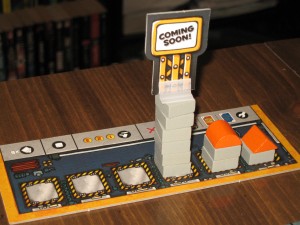
Players should try to plan ahead and pick the card types that they might need the most. Again, for you nitpickers without a sense of humor, the billboard shown was placed there for joke purposes only.
The Review
First and foremost, the kids and I appreciated the overall look and feel of the game. The components were bright and colorful. When the kids weren’t messing around with building “The Leaning Tower of Pisa”, they were often drawn to the artwork. Oh, and it wouldn’t be a review of mine if I didn’t mention that the game came with extra zip baggies…thank you for that!
Gameplay was very quick, even for our first game. The turns and phases went by smoothly…we only caught ourselves pausing when we were figuring out where to place a building after playing a contract card. I can see ourselves playing this during the week when we don’t have a lot of time for longer board games.
Vinnie Jr., the eleven year old, said that he enjoyed constructing his buildings but also liked the challenge of figuring out how high to make them and what rooftops to use based on the current board layout.
Anthony Jr. the sixteen year old, said that he enjoyed the hands on construction aspects as well, but wished the game was longer and the board bigger. He often made buildings that were ten to twenty stories high…mainly because he could and not because it was the best strategy. This didn’t deter us from having a good time, though.
Overall, it was a fun, light city-builder. It doesn’t rank up there among my favorites, but it doesn’t rank among the ones I can’t stand either. It will definitely serve as an alternative on family game night when we are tired of playing our more popular, prefered titles.
*A word of warning about the “Tanga” site that I mentioned at the beginning of the article: It took five days for “Skyline 3000″ to ship and roughly five days to get to me. I ordered another game from the same site and received an email ten days later that it was out of stock. Even though both games were cheap to buy, the customer service and shipping were terrible. I will be sticking to Amazon from here on out.
Final Verdict: 7/10

